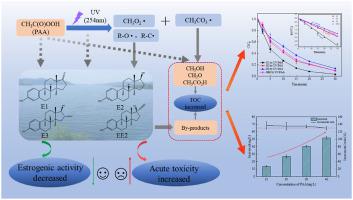Chemosphere ( IF 8.8 ) Pub Date : 2021-09-15 , DOI: 10.1016/j.chemosphere.2021.132261 Jun Hu 1 , Tong Li 1 , Xuxiang Zhang 1 , Hongqiang Ren 1 , Hui Huang 1

|
Steroid estrogens (SEs) are a group of refractory organic micropollutants detected in secondary effluent frequently. The advanced oxidation processes (AOPs) are usually used to deep remove the SEs from the secondary effluent. Herein, we first investigated the UV/peracetic acid (PAA), a PAA-based AOP, to degrade SEs. Using estrone (E1), 17β-estradiol (E2), estriol (E3), and 17α-ethinyl estradiol (EE2) as representatives, the results showed that UV can effectively activate PAA to enhance the degradation of the four SEs, which degradation followed the pseudo-first-order kinetics (R2 > 0.99), and the rate constant (kobs) of degradation increased with increasing the PAA dosage in the range investigated. Little pH dependence was also observed in the degradation of SEs by UV/PAA. Furthermore, the degradation of SEs was improved in the presence of coexisting substrates (Cl−, HCO- 3, NO- 3, and HA) in relatively low concentrations. Quenching experiments revealed that the carbon-centered radicals (R–C•) produced from the UV/PAA process were recognized as the predominant contributors to the degradation of the four SEs. Also, we found that the estrogenic activity decreased by more than 94%, but the acute toxicity inhibition increased to 37% in the solution after 30 min UV/PAA treatment. In addition, the 130% additional total organic carbon (TOC) was generated after UV/PAA process. These findings obtained in this work will facilitate the development of the UV/PAA process as a promising strategy for the deep removal of SEs in secondary effluent.
中文翻译:

UV/过氧乙酸降解类固醇雌激素:影响因素、自由基贡献和毒性分析
类固醇雌激素 (SEs) 是一组在二级出水中经常检测到的难降解有机微污染物。高级氧化工艺 (AOP) 通常用于从二级流出物中深度去除 SE。在此,我们首先研究了紫外线/过氧乙酸 (PAA),一种基于 PAA 的 AOP,以降解 SE。以雌酮(E1)、17β-雌二醇(E2)、雌三醇(E3)和17α-乙炔雌二醇(EE2)为代表,结果表明UV可有效激活PAA,促进4种SEs的降解,降解随之而来准一级动力学 (R 2 > 0.99) 和速率常数 ( k obs) 的降解随着研究范围内 PAA 剂量的增加而增加。在 UV/PAA 对 SE 的降解中也观察到很少的 pH 依赖性。此外,在共存底物(Cl -、HCO-3、NO-3 和 HA) 的浓度相对较低。淬火实验表明,UV/PAA 过程产生的以碳为中心的自由基 (R–C•) 被认为是四种 SE 降解的主要因素。此外,我们发现雌激素活性降低了 94% 以上,但在 UV/PAA 处理 30 分钟后,溶液中的急性毒性抑制增加到 37%。此外,UV/PAA 工艺后产生了 130% 的额外总有机碳 (TOC)。在这项工作中获得的这些发现将促进 UV/PAA 工艺的发展,作为深度去除二次废水中 SE 的有前途的策略。

























 京公网安备 11010802027423号
京公网安备 11010802027423号